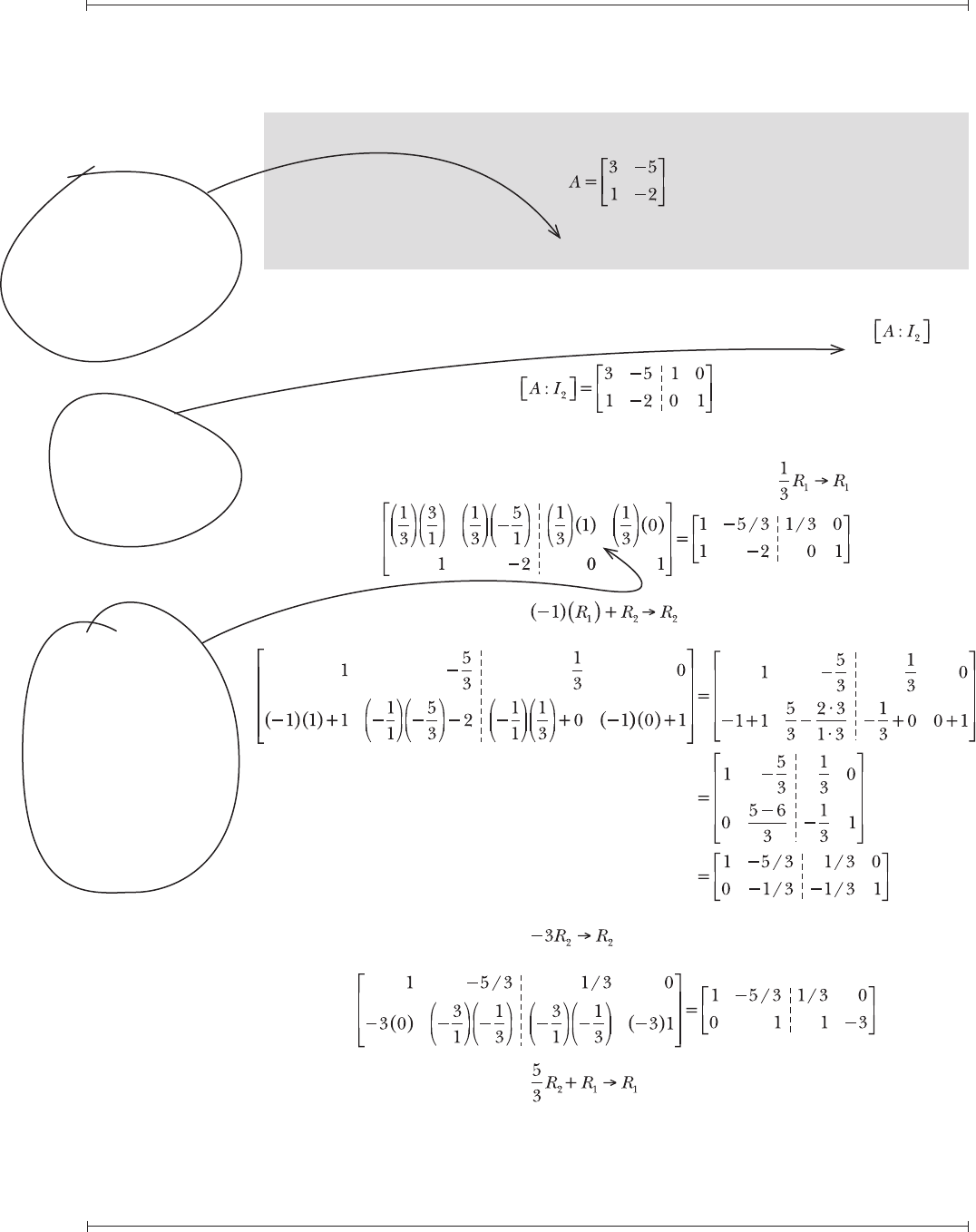
Chapter Ten — Applications of Matrix Algebra
The Humongous Book of Algebra Problems
228
Inverse Matrices
Matrices that cancel other matrices out
Note: Problems 10.34–10.35 refer to matrix A defined below.
10.34 Calculate the inverse matrix A
–1
of A.
Only square matrices have inverses. If matrix M has order n × n, the first step
toward identifying its inverse is to augment M with the identity matrix I
n
. In this
problem, A has order 2 × 2 so augment it with the identity matrix I
2
: .
Use the technique presented in Problems 10.19–10.22 to express A in reduced-
row echelon form. Begin by applying the row operation .
Apply the row operation to make a
21
= 0.
Apply the row operation to make a
22
= 1.
Apply the row operation to make a
12
= 0.
The notation
A
–1
means “the
inverse of matrix A,”
NOT “matrix A raised
to the –1 power.”
If you’re
not sure what
I
2
is, check out
Problem 10.4.
Everything
you do to the
2 × 2 matrix on
the left also trickles
over to the 2 × 2
matrix on the right, so
don’t forget to apply
the row operations
to the entire
row.

Chapter Ten — Applications of Matrix Algebra
The Humongous Book of Algebra Problems
229
The 2 × 2 matrix left of the dotted line is A
–1
, the inverse matrix of A.
Note: Problems 10.34–10.35 refer to matrix A defined below.
10.35 Verify that A · A
–1
= A
–1
· A = I
2
.
Calculate the product A · A
–1
.
Verify that the product A
–1
· A is equal to I
2
as well.
If two
matrices are
inverses, then
multiplying them in any
order produces an
identity matrix of
the same size.

Chapter Ten — Applications of Matrix Algebra
The Humongous Book of Algebra Problems
230
10.36 Given matrix B defined below, calculate the inverse matrix B
–1
.
Construct the augmented matrix .
Express B in reduced-row echelon form, beginning with the row operation
to make b
11
= 1.
Now apply the row operation to make b
21
= 0.
The matrix right of the dotted line is the inverse matrix of B.
10.37 If C and D, as defined below, are inverse matrices, calculate the value of v + w.
According to Problem 10.35, the product of two n × n inverse matrices is the
identity matrix I
n
.
Calculate the product of the matrices.
You didn’t
have to worry
about making
b
12
= 0 to complete
reduced-row echelon
form because it’s
already 0!

Chapter Ten — Applications of Matrix Algebra
The Humongous Book of Algebra Problems
231
Because the matrices in this equation are equal, each of the corresponding
pairs of elements must be equal. Of particular interest is the pair of elements in
the lower-left corners of the matrices.
6w = 0
Solve the equation for w.
Substitute w = 0 into the matrix equation.
Note that the elements in the first row and second column of each matrix are
equal as well.
Finally, evaluate the expression v + w, as directed by the problem.

Chapter Ten — Applications of Matrix Algebra
The Humongous Book of Algebra Problems
232
10.38 Given matrix N defined below, calculate the inverse matrix N
–1
.
Construct the augmented matrix .
Use row operations to express N in reduced-row echelon form, beginning with
to make n
11
= 1.
Apply the row operation to make n
21
= 0.
Look at
Problems 10.26–
10.31 if you need to
review transforming
3 × 3 matrices into
reduced-row
echelon form.
..................Content has been hidden....................
You can't read the all page of ebook, please click here login for view all page.
